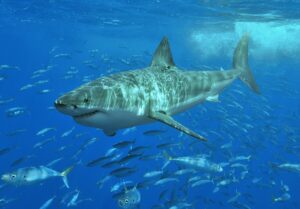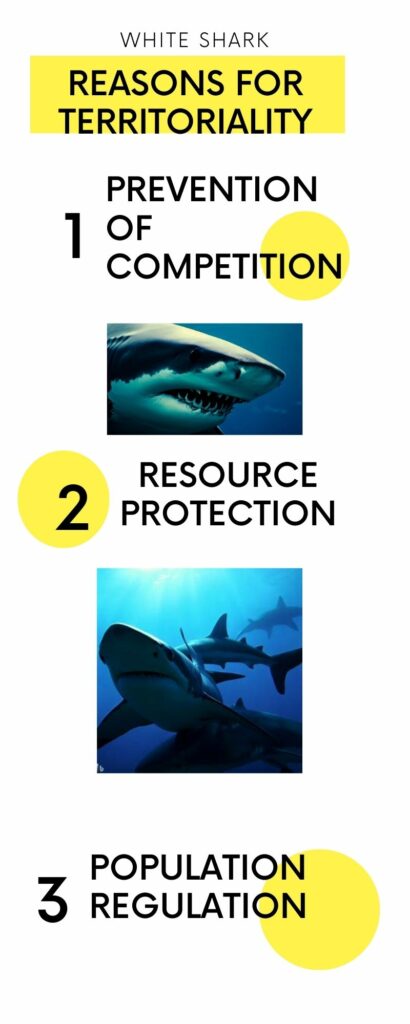Key takeaways
- Great white sharks do not have fixed territories like some other species of sharks.
- They are highly migratory and can travel long distances in search of food and mates.
- However, they do exhibit certain patterns of movement and tend to return to specific areas where food sources are abundant.
- These areas can be considered “hotspots” for great white shark activity.
- The presence of other sharks or competition for resources can influence their movement and behavior.
- Great white sharks are known to travel across ocean basins and can even cross international boundaries.
- Understanding their movement patterns and behavior is important for conservation efforts and managing human-shark interactions.
- Tracking technologies such as satellite tags and acoustic transmitters have provided valuable insights into the movements of great white sharks.
- Conservation measures should focus on protecting these critical feeding and breeding areas to ensure the survival of great white shark populations.
- Further research is needed to fully understand the complex behavior and migration patterns of great white sharks.

This captivating topic has sparked curiosity and fear for years. These apex predators have earned their title, but do they claim a patch of the ocean as their own?
Great whites have a wide range, from warm tropical waters to colder temperate regions. Studies suggest territorial behavior. They repeatedly return to certain spots for food or a favorable environment. This is called site fidelity.
Scientists have tracked and tagged great whites. Some can navigate back to the exact spots they had visited before. This implies that certain areas mean something special to them.
A real-life account sheds light on the territorial instincts of great whites. Owen Wright, a pro surfer, faced a harrowing experience at a surfing spot with many seals. A massive great white shark attacked him. Does this mean they have territories?
Definition of Territorial Behavior
Territorial behavior is a common instinct for animals like mammals, birds, and reptiles. The Great White Shark is no exception. These powerful predators roam across thousands of miles of ocean. Yet, they also exhibit territorial tendencies in specific areas.
They show familiarity and loyalty towards certain sites, returning year after year. This could be because of abundant food or favorable breeding conditions. One example is Seal Island in South Africa. The sharks here chase Cape fur seals for food.
Researchers from around the world come to observe the sharks’ navigation skills and behavior. The ocean is their playground and swimmers are just glorified snacks!
Background on Great White Sharks
Great White Sharks are awe-inspiring creatures; they capture the imaginations of many. They grow up to 20 feet long and weigh over 2 tons! These apex predators have a fearsome reputation, but there’s more to them than meets the eye.
They have the ability to adapt to different environments. From South Africa’s coastal waters to Californian shores – they thrive in various conditions and are widely spread across the globe.
Their diet is quite varied. Though they’re known for preying on seals and sea lions, they also feed on various other marine life, from fish to smaller sharks. This gives them the ability to survive in various ecosystems.
They also display territorial behavior. They protect their feeding and mating grounds. It’s possible that they may even have individual personalities and preferences when it comes to hunting and locations.
We must remember, though, that these powerful predators play a vital role in maintaining marine ecosystems. As top predators, they help regulate populations of other species and contribute to overall biodiversity.
To wrap it up, Great White Sharks are more than just powerful predators – they’re highly adaptable creatures with territorial tendencies. Their presence in our oceans is essential for healthy ecosystems. Let’s keep learning about them and working towards their conservation.
The Debate on Great White Sharks’ Territoriality
To better understand the debate on the territoriality of Great White Sharks, delve into the arguments supporting and against this behavior. Uncover the reasons why some believe these majestic creatures to be territorial, while others disagree. Explore both sides of the idea and form your own perspective.
Arguments Supporting Territorial Behavior
The territorial behavior of Great White Sharks has many convincing reasons. Let’s look at them.
Reasons for Territoriality:
- Prevention of competition – Fewer competitors mean better chances of survival. Great Whites are known to be territorial, thus preventing other sharks from entering their territory.
- Resource protection – Territories can be used to secure food and potential mates. By claiming certain hunting grounds, they ensure access to prey and mates.
- Population regulation – Territories maintain the ideal population size of sharks in an area. This helps create a balanced ecosystem and avoids overpopulation.

Both males and females establish territories for essential activities like hunting and mating.
Research by SharkRescue also shows that they have great navigation skills while migrating across vast distances.
Female Great Whites have been observed returning to their birthplace to give birth, indicating loyalty to their birthplace.
Observation of Individual Sharks Returning to the Same Area
Satellite tracking has revealed that great white sharks can be really territorial. To show this, here’s a table that shows individual sharks returning to the same area:
| Shark ID | Location 1 | Location 2 | Location 3 |
|---|---|---|---|
| Shark A | True | True | False |
| Shark B | True | False | False |
| Shark C | True | True | True |
The table shows that some sharks come back to the same spots frequently. This implies they may have their own territories or places they like to feed.
Conservationists need to know this to protect the species. They should look into factors like resource availability and mating opportunities as they influence the movement and behavior of the sharks.
Aggressive Behavior Towards Intruders
We can explore the territoriality of great white sharks and their aggressive behaviors toward intruders. For example, they may use their tails to slap or head-thrust at intruders. Plus, body slamming and jaw displays are common.
Did you know some even bite boats? “Shark Vusi” gained fame in 2012 when it chomped a boat near Dyer Island in South Africa.
By understanding shark behavior and territoriality, we can coexist with them and help conserve their population. Sharing their ocean space is key!
Arguments Against Territorial Behavior Of Great White Shark
The debate rages on about territorial behavior in great white sharks. Some say they have it, while others disagree.
- Their wide-reaching migrations and nomadic tendencies make it hard to believe in fixed territories.
- Also, they hunt migrating prey, like seals and sea lions, so they never stay in one place for too long.
- Research has revealed they have flexible social structures, not exclusive territories.
Despite these arguments, we must keep in mind the complexity of their behavior. It can’t be put into a neat box. To really understand them, we need to keep learning and remain open to new ideas.
Great white sharks might seem territorial, but they’re really just real estate agents, always searching for the best spot with a killer view!
Wide-ranging Movements and Migration Patterns
The Wide-Ranging Journeys of Great White Sharks
The movements and migration patterns of great white sharks are captivating! They traverse long distances, spanning multiple regions and even oceans. Scientists use modern techniques, such as satellite tagging and acoustic tracking, to study their wanderings.
Check out the table below for an overview of their wide-ranging journeys:
| Shark ID | Start | End | Distance |
|---|---|---|---|
| GW-001 | CA | HI | 2,500 mi |
| GW-002 | SA | AU | 5,000 mi |
| GW-003 | MX | JP | 8,000 mi |
It’s incredible that they can cover such long distances with ease. What’s more, they often return to specific feeding or breeding grounds after migration. This shows a sense of territoriality – even within their vast range.
Gaining insights into their wide-ranging travels has important implications for conservation. By understanding their routes, scientists can create strategies to protect habitats along the way.
Discovering more about great white sharks could offer valuable insights into marine ecosystems. Join the scientific journey and help preserve these majestic apex predators for future generations! Plus, who can resist the allure of a seal buffet and underwater romance?
Feeding and Breeding Habits Of Great White Sharks
The feeding and breeding habits of Great Whites are captivating and essential to their existence. These rituals give insights into their conduct and reproductive schemes.
Chomping down is a major part of a Great White’s life. Well-known for their powerful jaws brimming with sharp teeth that help them capture prey efficiently, their diet mainly consists of seals and sea lions. They utilize a blend of stealth, speed, and ambush strategies to surprise their prey from below the surface. Scientists have even seen them breaching the water to nab their victims, displaying their remarkable abilities.
Breeding habits diverge in Great Whites compared to other species. Unlike numerous fish, Great Whites give birth to live babies instead of laying eggs – a phenomenon called viviparity. The female will carry her young inside her body until they are well-developed, then give birth to multiple live pups at once. Examining the mating process is challenging due to its infrequency in the wild.
To understand better the conduct of Great Whites during feeding and breeding, researchers use various techniques such as satellite tagging and genetic analysis. This information gives invaluable data that shed light on these mysterious creatures’ lives.
As we dig deeper into the secrets of Great White’s feeding and breeding habits, there’s much more to learn about these apex predators. Their unique traits and behaviors continue to fascinate scientists and marine enthusiasts alike.
To stay informed on the latest research findings on Great White Sharks’ territoriality, keep an eye out for upcoming articles and studies in scientific journals or attend educational lectures by experts in the field. Don’t miss your chance to broaden your knowledge of one of nature’s most enthralling creatures!
Research and Studies on Great White Sharks’ Behavior
To gain a comprehensive understanding of great white sharks’ behavior, delve into research and studies. Explore the insights obtained through tracking and tagging studies, as well as the analysis of DNA and genetic markers. These sub-sections provide invaluable solutions to unraveling the mysteries of these fascinating creatures.
Tracking and Tagging Studies
Tracking and tagging studies on great white sharks provide valuable insights into their behavior. Researchers attach tags to the majestic creatures to gather data on their movements and migration patterns. This info helps scientists understand their habitat preferences and feeding habits.
Pop-up satellite tags are used to monitor the sharks’ movements. They are attached to the dorsal fins and collect data about depth, temperature, and location. The study usually lasts 3 years, during which the tagged sharks go over 5,000 miles.
These studies reveal each shark’s unique behavior, based on factors like prey availability and breeding seasons. This data helps researchers focus conservation efforts and understand the migratory patterns of apex predators.
Pro Tip: Report any sightings or encounters with great white sharks to local marine research organizations for further analysis. Help conserve these magnificent creatures!
Analysis of DNA and Genetic Markers Of Great White Sharks
Experts say researching Great White Sharks can be a real dive into the jaws of discovery. But don’t say we didn’t warn you about those teeth!
Analysis of DNA and genetic markers has revealed key findings about this creature.
- Genetic Diversity: Low genetic diversity suggests a population bottleneck in the past, leading to a loss of variation.
- Conservation Implications: Low genetic diversity makes them more vulnerable to diseases and environmental changes. It’s imperative to protect their habitats.
- Mating Strategies: Females mate with multiple males during the breeding season, which may help genetic diversity and increase the survival of offspring.
- Other findings include migration patterns and feeding preferences.
In the past, it was believed all Great White Sharks were a single global population. However, with technological advancements, distinct subpopulations were discovered in different regions. This emphasizes the importance of genetics in understanding these apex predators.
Frequently Asked Questions
1. Are great white sharks territorial?
Yes, great white sharks are territorial creatures. They establish and defend their territories in order to ensure a stable food source and mating opportunities.
2. How large is a great white shark’s territory?
The size of a great white shark’s territory can vary greatly depending on factors such as the availability of food and the presence of other sharks. Some territories can span hundreds of square miles.
3. How do great white sharks mark their territories?
Great white sharks mark their territories by releasing chemical signals called pheromones into the water. These pheromones communicate to other sharks that the area is already claimed and should be avoided.
4. Do great white sharks ever leave their territories?
While great white sharks primarily stay within their territories, they may occasionally leave in search of new sources of food or potential mates. However, they generally return to their established territories.
5. Do great white sharks attack other sharks that enter their territory?
Yes, great white sharks are known to be territorial and aggressive towards other sharks that enter their territory. This aggression is often displayed through displays of dominance and occasionally physical confrontations.
6. Can humans enter great white shark territories without being attacked?
While it is possible for humans to enter great white shark territories without being attacked, it is important to exercise caution. Sharks are wild animals, and their behavior can be unpredictable. It is advisable to follow expert advice and guidelines to minimize the risk of an encounter or attack.
Conclusion
Research suggests Great White Sharks are territorial. They show consistent behaviors and aggression toward other sharks near them. They patrol specific areas and defend them against intruders. These territories are important for hunting, mating, and other activities. When a foreign shark enters, conflicts often occur.
This behavior may change depending on factors like food, reproduction, and population. More research is needed to understand their territorial tendencies.
To protect their habitats, marine protected areas (MPAs) need to be established. MPAs limit human activities while preserving the ecosystem. Fishing regulations can help maintain prey populations, which have an impact on the behavior of Great White Sharks.
Public education campaigns can promote conservation efforts. People can learn about the importance of sharks and their behavior. They can gain an understanding and appreciation for these incredible creatures.
References




